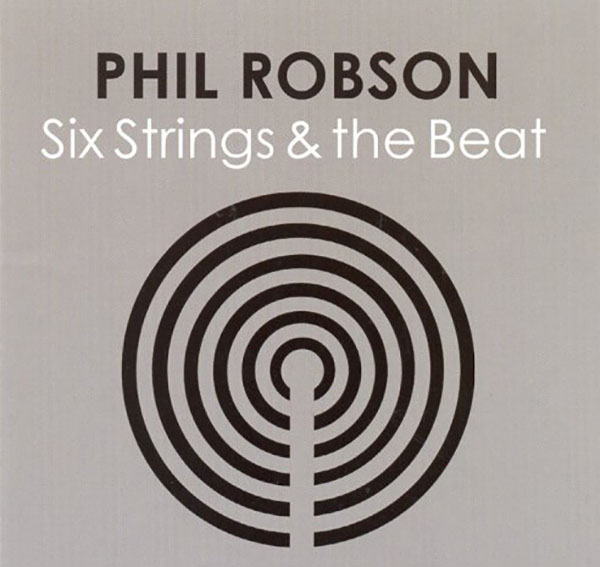
by Ian Mann
August 12, 2008
/ ALBUM
Robson's intelligent writing together with superb playing from all involved makes this one of the key releases of the year.
Guitarist Phil Robson is a remarkably versatile player and is at home in a wide variety of jazz contexts, from the swing of the BBC Big Band to the scalding jazz rock of Partisans, the band he co-leads with saxophonist Julian Siegel. He is a player with an international reputation, collaborating with the Americans James Genus and Billy Hart on his second solo album “Screenwash”(Babel, 2003). More recently he undertook a successful UK tour with American saxophone colossus Dave Liebman, playing a repertoire of standards and Robson originals.
However Robson’s third solo recording “Six Strings And The Beat” represents a considerable departure from anything he has done before. The album marks Robson’s increasing maturity as a writer and was the result of a commission for Derby Jazz Week 2007. Derby is Robson’s hometown and he wanted to come up with something special. At the suggestion of his partner and frequent musical collaborator, the singer Christine Tobin, he decided to write for an ensemble fusing the traditional classical string quartet with jazz instruments. Hence the title “Six Strings And The Beat” with no less than six string players-Robson, Austrian double bassist Peter Herbert plus Emma Smith and Jenny May Logan (violins), Naomi Fairhurst (viola) and Kate Shortt (cello) combining with Partisans drummer Gene Calderazzo (the beat). Tobin adds her distinctive vocals to two of the tracks.
At first glance this might seem like an attempt to capitalise on the success enjoyed by Mercury Music Prize nominees Basquiat Strings, especially as Smith and Logan are also members of that ensemble. However the presence of Robson’s guitar gives this line up a significantly different voice and with his writing embracing a wide dynamic range and a variety of styles “Six Strings And The Beat” is a triumph in it’s own right.
There are similarities to the Basquiats in the ways in which the strings are deployed with the players making regular use of pizzicato as well as the bow. They are also adept at switching between solo and ensemble playing .The quality of the writing ensures that the strings are fully integrated with the jazz elements and Smith and Shortt are both talented improvisers themselves.
The quality and variety of the writing in a well-balanced programme ensures that the album always engages the listener’s attention. The breezy riffing of “Rubber Duck” makes it an attention-grabbing opener with Robson contributing a solo that draws on his deep-seated love of bebop.
The brooding “Quick Silver” is a vehicle for Herbert to show his improvising skills both with and without the bow. The sympathetic backing from the other string players sustains the unsettling mood brilliantly. Robson acknowledges the influence of Bela Bartok here.
The charming “Songbird” was inspired by Malian singer Oumou Sangare with plucked strings approximating the sound of the kora as Kate Shortt’s cello takes flight.
The haunting ballad “Hold You” features the lustrous tones of the Irish born Tobin, a performer who has matured into one of this country’s best vocalists.
The freewheeling swirl of “The Mook” pays tribute to Ornette Coleman with darting violins and polyrhythmic drumming from the hitherto understated Calderazzo.
“Louisiana”, Robson’s memorial for the victims of Hurricane Katrina is perhaps the focal point of the album. Out of mournful strings and delicate acoustic guitar an anguished Hendrix style wail of electric guitar erupts from the main body of the tune.
The piece is dramatic and impressive and is perhaps best viewed as a protest song without words.
The wistful “Wishing Well” features the wordless vocals of Tobin allied to Robson’s sympathetic acoustic guitar accompaniment. Somehow it’s quiet fragility reminds me of Robert Wyatt and the Canterbury Scene.
The highly melodic “Silver Threads” cradles Robson’s Pat Metheny like guitar in a lush backdrop of strings with Smith and Shortt also featuring strongly. Calderazzo’s polyrhythmic propulsion adds impetus to yet another fine composition.
“Hillbleeoos” finds Robson adding country and bluegrass elements to his bebop licks, an acknowledgement perhaps to the influence of Bill Frisell.
The spiky “Sticks & Stones” ensures that the listener’s attention is held to the very end. The intro features the string players deploying the bodies of their instruments for percussive effects.
All ten tracks on this album are significantly different and Robson has programmed them in such a way as to ensure that the surprises just keep on coming. The guitarist himself plays in a number of styles from pretty acoustic to bellicose electric and all points in between, encompassing a wide jazz vocabulary.
Calderazzo is a revelation. A powerhouse of a drummer with the Partisans his trio work with pianist Zoe Rahman has revealed a more subtle and sympathetic side to his playing. He takes this aspect to another level here.
“Six Strings And The Beat” has been greeted with almost unanimous critical acclaim and Robson fully deserves the plaudits that have come his way. Intelligent writing and superb playing from all involved make this one of the key releases of the year.
blog comments powered by Disqus